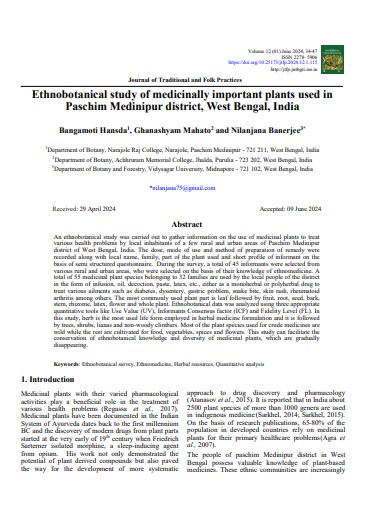Ethnobotanical study of medicinally important plants used in Paschim Medinipur district, West Bengal, India
Keywords:
Ethnobotanical survey, Ethnomedicine, Herbal resources, Quantitative analysisAbstract
An ethnobotanical study was carried out to gather information on the use of medicinal plants to treat various health problems by local inhabitants of a few rural and urban areas of Paschim Medinipur district of West Bengal, India. The dose, mode of use and method of preparation of remedy were recorded along with local name, family, part of the plant used and short profile of informant on the basis of semi structured questionnaire. During the survey, a total of 45 informants were selected from various rural and urban areas, who were selected on the basis of their knowledge of ethnomedicine. A total of 55 medicinal plant species belonging to 32 families are used by the local people of the district in the form of infusion, oil, decoction, paste, latex, etc., either as a monoherbal or polyherbal drug to treat various ailments such as diabetes, dysentery, gastric problem, snake bite, skin rash, rheumatoid arthritis among others. The most commonly used plant part is leaf followed by fruit, root, seed, bark, stem, rhizome, latex, flower and whole plant. Ethnobotanical data was analyzed using three appropriate quantitative tools like Use Value (UV), Informants Consensus factor (ICF) and Fidelity Level (FL). In this study, herb is the most used life form employed in herbal medicine formulation and it is followed by trees, shrubs, lianas and non-woody climbers. Most of the plant species used for crude medicines are wild while the rest are cultivated for food, vegetables, spices and flowers. This study can facilitate the conservation of ethnobotanical knowledge and diversity of medicinal plants, which are gradually disappearing.


